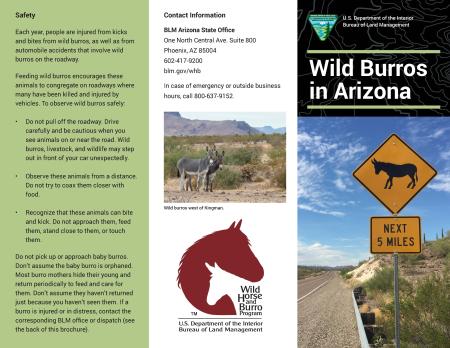Wild Burros in Arizona

The wild burros on BLM-managed public lands provide a unique experience we hope you will enjoy, but please remember: they are undomesticated animals and can be dangerous.
Natural History
Wild burros (a Spanish term for donkey) can survive high temperatures using shade and being most active in early morning and late afternoon hours. Though wild burros can be versatile in their diet, herd management areas (HMA) across Arizona consist of browse-type communities made up of shrubs and trees with limited grasses to graze on. Wild burros will take advantage of summer bean crops from mesquite, palo verde, and ironwood trees. During the spring, burros will consume annual vegetation sprouted from winter precipitation. They are generally less than half the size of a horse. The average weight of an adult is 400 pounds with males (jacks) being slightly larger than females (jennies).
Foals are mainly born during the spring season (February–May) but births have been known to occur outside the typical foaling season. The gestation period (pregnancy) is 9-13 months. This inconsistent gestation period allows pregnant burros to hold onto foals longer if conditions are not favorable (climatic and or resource availability).
Domestic burros have been known to live more than 30 years when people feed and care for them. In the wild, they average about 10-12 years.
Burros evolved in the deserts of northern Africa where the average rainfall is about two inches a year. Two populations of burros from northern Africa that were separated from each other by natural barriers are attributed with being the ancestors of today’s burro in the American Southwest. These are the Nubian and the Somalian. The Nubian’s characteristics are a black stripe across the shoulders and another down the middle of the back giving the appearance of a cross when viewed from above. The Somalian has leg stripes on both front and hind legs resembling a zebra’s markings. These characteristic differences may be seen in the numerous individual wild burros in Arizona.
Burros in the Americas
Early explorers brought both horses and burros to the New World. Some of these animals were released or escaped to the deserts of the southwestern United States and Mexico. With the discovery of more gold and silver in the 1800s, miners brought more burros with them. These animals added to the small early populations and began to breed and increase in numbers.
Wild burros have been known to be predated by mountain lions. However, the limited predation that occurs on wild burros is not enough alone to maintain their populations in check.
Managing Burros
The Wild and Free-Roaming Horse and Burro Act (Public Law 92-195), passed in 1971, charged the Bureau of Land Management with managing wild burros in a thriving natural ecological balance with other plants and animals in the environment to maintain healthy ecosystems.
Wild burros removed from HMAs due to overpopulation, emergency situations, or through nuisance removals become available for adoption through the BLM’s Wild Horse and Burro Adoption Program. Wild burros can also be viewed or adopted by visiting the BLM’s Florence Wild Horse and Burro Training and Off-Range Corral.
Safety
Each year, people are injured from kicks and bites from wild burros, as well as from automobile accidents that involve wild
burros on the roadway.
Feeding wild burros encourages these animals to congregate on roadways where many have been killed and injured by vehicles. To observe wild burros safely:
- Do not pull off the roadway. Drive carefully and be cautious when you see animals on or near the road. Wild burros, livestock, and wildlife may step out in front of your car unexpectedly.
- Observe these animals from a distance. Do not try to coax them closer with food.
- Recognize that these animals can bite and kick. Do not approach them, feed them, stand close to them, or touch
them.
Do not pick up or approach baby burros. Don’t assume the baby burro is orphaned. Most burro mothers hide their young and return periodically to feed and care for them. Don’t assume they haven’t returned just because you haven’t seen them. If a burro is injured or in distress, contact the corresponding BLM office or dispatch.
Contact Information
BLM Arizona State Office
One North Central Ave. Suite 800
Phoenix, AZ 85004
602-417-9200
blm.gov/whb
In case of emergency or outside business
hours, call 800-637-9152.
